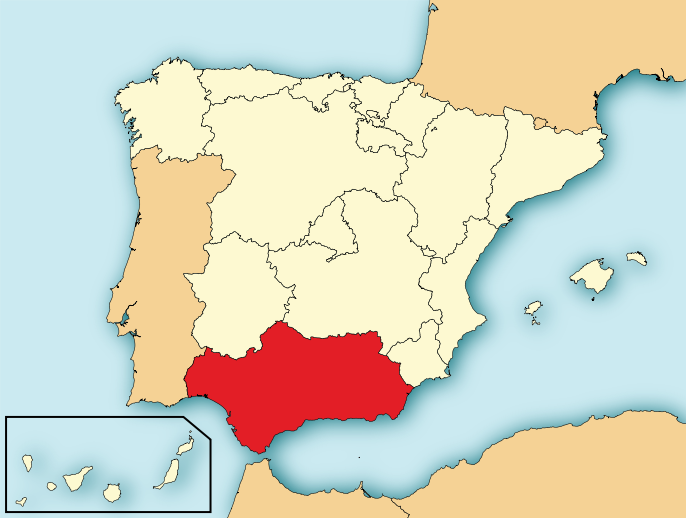ANDALUCÍA Every autonomous region of Spain celebrates its Day. This one is ours. Anyone with a child in primary school in Andalucía will not be allowed to forget it, as the kids are involved in numerous activities and events related to it. And anyone with a child, etc. will know that Monday is also a holiday, by sheer coincidence, of course. But to go somewhat deeper than that, below are a few pieces of information that, if not useful, they at might at least be interesting. True, over the years, at about this time, we publish items related to the community in which we have chosen to live (a couple of links are below).>>>
IF YOU FIND THIS ARTICLE INTERESTING, USEFUL OR ENTERTAINING, PLEASE CONSIDER THE WORK, EFFORT AND COST IT TAKES TO BRING IT TO YOU. WE WOULD APPRECIATE A DONATION TO CONTINUE A FREE SERVICE.
- Andalucía is the most populous (8,285,692 inhabitants) and the second largest autonomous region of Spain.
- Andalucía is bordered by the the following: Extremadura and Castilla-La Mancha in the North, Murcia on the East, Portugal to the West, Gibraltar and the Straits to the South.
- Andalucía consists of the provinces of Almería, Cádiz, Córdoba, Granada, Huelva, Jaén, Málaga, Sevilla.
- Each of the provinces bears the name of its capital city.
- The capital of Andalucía is Sevilla.
- Andalusia is traditionally divided into two historical subregions: Upper or Eastern Andalucía, consisting of the provinces of Almería, Granada, Jaén, and Málaga, and Lower or Western Andalucía, consisting of the provinces of Cádiz, Córdoba, Huelva and Seville.
 |
| 771 municipalities: Can you point to the seven that are the Campo de Gibraltar? |
- There are 771 municipalities in Andalucía, and 59 mancomunidades, set up as associations of municipalities to promote development and coordination among them in areas sometimes also known as comarcas.
- 5.35% of the population of Andalucía was born outside of Spain (data: 2009).
- Of the above, British nationals make up 15.25%, concentrated mainly in the province of Málaga.
 |
| Blas Infante, the Father of Andalucía |
- Blas Infante is considered the Father of Andalucía (born in Casares on July 5, 1885).
- The word Andalucía entered the Spanish language in the 13th Century, probably derived from the term Al-Andalus, itself derived from the Arabic/Moorish term Al-Andalusiya, which is believed to be a corruption of Vandalus, or Land of the Vandals, the Germanic tribe that invaded the Iberian Peninsula after the fall of the Roman Empire.
 |
| Flat Cordoban sombreros, 'typical Andalusian' |
- The traditional 'image' of Spain is that of the flamenco dancers, bullfighters and flat Cordoban sombreros (hats), all of which and more are identified almost exclusively with Andalucía, to the chagrin of other regions. This is probably owed to the advent of tourism to the coasts of Andalucía in the 1960s, rather than to the North.
- Flamenco, identified closely with Andalucía but now spread throughout the world, is said to have developed in the 18th Century, but is based on other musical forms of the region. There is a clear association with Arabic musical forms but the major influence is that of the Romani people, or Gypsies, who emigrated from Northern India as early as 1000 AD, thus providing the influence of all the countries between there and here.
- Most of the Spaniards who 'conquered' America -the Conquistadores- came from the regions of Andalucía (principally from Huelva and Sevilla in the West) and Extremadura.
- The Roman name for Andalucía was Baetica, whence the name for a football club in Sevilla: Betis. This word, or derivations, is often used as another word for the region.
 |
| Europe's largest solar power tower is in the province of Sevilla |
- Europe's largest solar power tower, the PS10, is located in Sanlúcar la Mayor, in the province of Sevilla. This is also the largest solar power facility in Europe.
- Andalusian Spanish is one of the most widely spoken forms of Spanish in Spain, and because of emigration patterns was very influential on American Spanish. Rather than a single dialect, it is really a range of dialects sharing some common features; among these is the retention of more Arabic words than elsewhere in Spain.
- Most Spanish dialects in Spain differentiate between the sound of "z" and "c" (before e and i), pronounced as in 'the', known as Ceceo, and that of "s", pronounced as in 'see' and known as Seseo. Other areas retain the distinction found elsewhere in Spain.
- There are 227 fincas de ganado (fighting bull farms) in Andalucía.
- The oldest bullring still in use is that of Ronda, built in 1784.There are about 100 bullrings in Andalucía.
Source: Wikipedia, where you can find all kinds of fascinating information about Andalucía, as we have above.






No comments:
Post a Comment